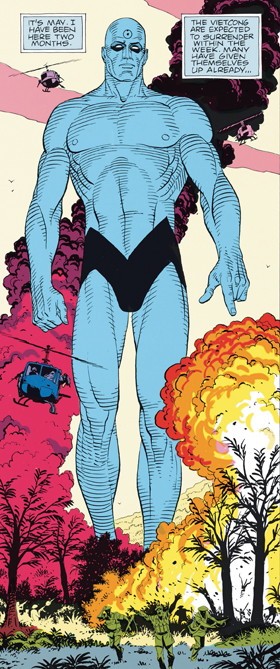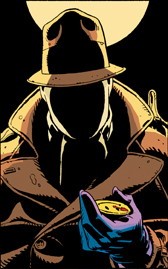Comical hype
What makes Watchmen such a milestone anyway?
It was a comic unlike any seen before.
First published in 1986, the 12-issue DC Comics series Watchmen, written by Alan Moore and drawn by Dave Gibbons, would become the first – and, to present – only comic to win a Hugo Award, given to recognize the best works in science fiction and fantasy.
More recently, Time magazine named it one of the 100 best novels since 1923, calling it “a heart-pounding, heartbreaking read and a watershed in the evolution of a young medium.” The novel takes place in an alternate history where superheroes helped the U.S. win the Vietnam War, the country is close to a nuclear war with the Soviet Union and most costumed superheroes are retired or working for the government. A group of superheroes are pulled out of retirement after one of their own is murdered.
Watchmen has been taught at universities, including the University of Winnipeg. Thus one trailer for the new movie adaptation hailed the source material as “the most celebrated graphic novel of all time.”
Myth
But what exactly makes Watchmen such a milestone?
One reason may be its treatment of the superhero myth. As Moore told BBC Four’s Comics Britannia in 2007, he was trying to situate his superhero characters in the context of the real world. He asked, wouldn’t these characters actually be a joke? For that matter, would such figures not also be “kind of sad and touching”?
Moore also said that no previous artists or writers had acknowledged the obvious political and sexual implications of superheroes. In the alternate 1986 world of Watchmen, the atomic-powered Dr. Manhattan has secured American victory in Vietnam. And there is recognition, even by the characters themselves, that there is an element of fetishism and fantasy to dressing up in costumes.
“ Perhaps most significantly, Watchmen recognizes the dark side of super heroism
The dark side
But perhaps most significantly, Watchmen recognizes the dark side of super heroism.
“A person dressing in a mask and going around beating up criminals is a vigilante psychopath,” Moore said. “That’s what Batman is, in essence.”
In Watchmen, he explained further, the vigilante named Rorschach was intended as a realistic consideration of Batman. Brandon Christopher, an assistant professor of English at the U of W who is contemplating using Watchmen in some of his own classes, says that Rorschach’s very face “is a symbol of psychiatric imbalance” – the Rorschach ink blot test. As Moore noted, a superhero in the real world would probably be frightening.
In Watchmen, a clear parallel is drawn between the overwhelming, yet nonetheless limited, power of the superhero, and the apocalyptic endgame of “Mutually Assured Destruction.” What the comic does, Christopher said, is show “the logical end of the superhero power fantasy” – that is, a world that has been made more dangerous.
Innovative form
But Watchmen was unprecedentedly innovative, not only in terms of story and theme, but also form.
“It is a pointed critique of the superhero story, told in the form of a superhero story,” said Nick Burns, a Winnipeg comic artist and writer.
Indeed, said Christopher, Watchmen’s story and presentation “are perhaps inextricable.” Burns insists that we must not undervalue the importance of Gibbons’ drawing style, which is traditional for the genre and evokes the style of 1950s DC superhero art.
This additional complexity is made possible through what he claims is perhaps comics’ most distinctive characteristic – that is, its existence as a drawn medium.
“Watchmen works on so many levels simultaneously [and] reflects the authors’ mastery of their medium,” Burns said.
For that matter, Moore told Entertainment Weekly last year that Watchmen was designed to show off things possible only in comics. Candida Rifkind, an assistant English professor at the U of W who lectures on comics, says that although comics are “a hybrid medium,” there has been resistance by comic creators – including Moore himself – to comparisons to film. Moore argued in the LA Times this past fall, approaching comics merely as films on a page leaves you with a movie “that does not move.”
In a 1988 interview originally published in Strange Things Are Happening, Moore cited comics’ unique juxtaposition of words and images, which allows for greater density of information. And since the reader can flip the pages back and forth, he continued, one can unpack that density at one’s own pace – giving comics particular potential to stimulate reflection.
Indeed, Watchmen is full of recurring motifs whose meanings become clear only by the end. The most celebrated example of this is a metafictional comic-within-a-comic, the Tales of the Black Freighter, which one character reads over several chapters of the novel. Echoing the style of ‘50s horror comics, the self-contained tale provides, in context, one more means of disquieting insight into Watchmen’s super-powered “heroes.”
In sum, Burns said, Watchmen remains a compendium of ways to play with comics storytelling. Today, however, it is perhaps difficult to fully appreciate its impact.
“It’s been so influential that Moore’s technique has now become commonplace,” Christopher said.
What has also become commonplace, he added, is the notion of heroism’s dark side. However, as Moore told Wired magazine in 2006, how this idea has been expressed since Watchmen has displeased him, as he feels his story’s gritty aspects have been only superficially adopted.
One thing is for sure: the superhero is still a prevalent phenomenon in our culture. And with superheroes perhaps more popular than ever on the big screen, Moore and Gibbons’ magnum opus remains as relevant today as it was in 1986.
Published in Volume 63, Number 23 of The Uniter (March 12, 2009)








